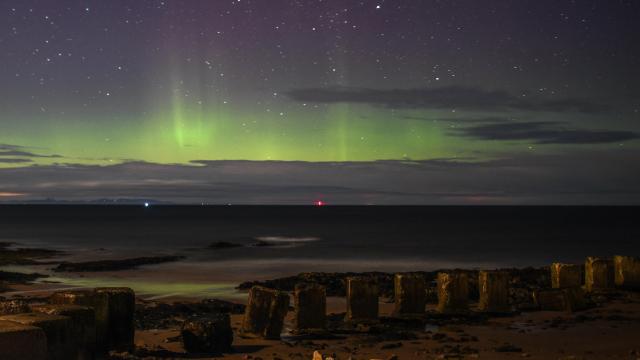If you happen to live on the northern end of the U.S., and you’re not completely engulfed by ambient light pollution, you might be in for a once-in-a-lifetime celestial light show, though a lot of things have to happen to make the aurora borealis, often called the Northern Lights, appear overhead.
This disturbance in the night sky is being called by a coronal mass ejection, otherwise known as a CME. These range in severity from G1 to G5, and this most recent storm is sitting at a G3 level. Part of the interest is that the start of this extended storm was caused by a so-called “cannibal” solar ejection event, when one CME collides with and consumes another.
The National Oceanic and Atmospheric Administration announced Tuesday that there were geomagnetic storm watches in effect for this week, and that a G2-level CME hit the Earth on Wednesday. This caused the aurora borealis to appear in the skies above Herzogswalde, Germany, according to Spaceweather.com.
Absolutely SPECTACULAR aurora today!!! Thankful for the recent solar activity resulting in these wonderful sights! pic.twitter.com/aOD45XSWaX
— Bob “Farmer” Hines (@Astro_FarmerBob) August 18, 2022
The Northern Lights usually stick closer to the north pole, and even in high latitude countries like Iceland, it’s still hard for the most ardent aurora hunters to catch a glimpse. For those trying to catch a glimpse before the weekend, you’ll want to keep track of NOAA’s forecasts for routine updates. If you think you have a shot, you need to find an area of high elevation without much or any light pollution. You should check the forecast for clouds as well, and be prepared to watch all directions for those pesky lights.
Essentially, the way it works is during a solar storm, the sun expels a large amount of plasma from the Sun’s corona, carrying an embedded magnetic field with it. These ejections travel the few days it takes to reach Earth, where they pull at the planet’s own magnetic field, causing rippling plasma waves. Electrons riding on these waves collide with our upper atmosphere and excite nitrogen and oxygen molecules. When those molecules finally start to release that pent up energy, they create the wavering light show known as the aurora borealis.
G1-G3 Watches are in effect for 17-19 August, 2022 due to likely CH HSS and CME influences. There is too much information to tweet about this activity – so please visit our webpage story at https://t.co/SitaSD3blc for all the information to keep properly informed. pic.twitter.com/E9K21u1TnJ
— NOAA Space Weather (@NWSSWPC) August 16, 2022
NOAA reported earlier Thursday that the area of impact was about 50 degrees latitude, meaning the storm was impacting an area as south as Illinois or Pennsylvania. The area of effect was pushing northwards, and as of Thursday afternoon UTC, NOAA reported that an area of impact is around 60 degrees latitude, and the aurora could be visible in states like Maine or the northern part of Michigan.
Solar storms interacting with Earth’s magnetic field can create electrical fields that can mess with or even damage some systems and could potentially lead to widespread blackouts, and some scientists have previously told Gizmodo it’s better if we’re prepared for such an event. There have been occasions where solar storms have caused some damage. There were past reports that solar storms caused sea mines to detonate and have caused some havoc with orbiting satellites. Studies have already calculated how a large solar storm might cause damage to the more sensitive parts of the U.S.’ power infrastructure, including parts of the East Coast and Upper Midwest.
Still, geomagnetic storms are common enough and, so far, most have been pretty harmless. The biggest of these CME events on record happened back in 1859 long before many U.S. homes were powered with electricity. It was dubbed the Carrington Event (after hobbyist astronomer Richard Carrington noticed the commotion through his telescope). NASA called it one of the greatest space weather events of the last 200 years. We could be due for another big event, but experts have said “space weather” is an incredibly hard subject to predict, and thanks to monitoring from the likes of the Space Climate Observatory satellite, we do often get days of warning before any solar storms actually reach our pale blue dot.
